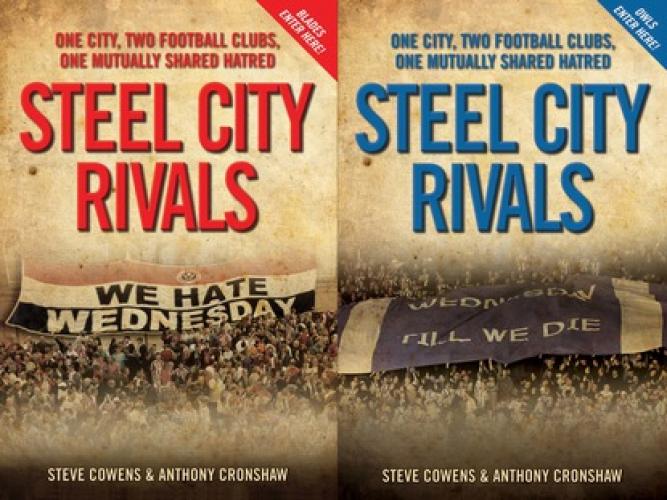CONTENTS
Blade Versus Owl
Background
The Steel City – ‘If You Know Your History’
Wednesday Rule OK
Sheffield Wednesday, 1967
Shandy Pants
Wednesday, My Part in Their Downfall
The Casuals are Coming
The Turning Point
Wednesday Hospitalised, The Hunt is On
Molotov Madness, Six Months of Madness
Attacked with Petrol Bombs
All’s Fair in Love and War
Bad Day at Black Rock
Wednesday’s Cop Out
Wednesday Centenary, 1989
Sunday, Bloody Sunday
United’s Double, Part 1
United’s Double, Part 2
Teaming Up
Sheffield’s Big Day Marred by Death of an Innocent Fan
Near-fatality at Steel City Cup
Attacked at Hillsborough
On England’s Green and Pastured Land
In the Cells Again
The Players, Passion and Pride
One Season, Three Derbies
The Tide is Turning!
Local Wars
The Battle of the Sportsman
The Sheffield Derby, 2002
Blades Lad Hammered
Songs Sung Blue, Everybody Knows One
Hillsborough Cornered
Conclusion
Epilogue: Wednesday Down, 2010
Owl Versus Blade
Dedication
Author Profile: Anthony Cronshaw
Editor Profile: Paul A Allen
Introduction
The Birth of a Rivalry
The First Derby Matches
New Home, New Century, Old Rivalry
Between the Wars
The Forties and Fifties
The Swinging Sixties
The Seventies
The Eighties and Nineties
Into the Millennium
Swamping the Shoreham
The Turning of the Tide
Requiem for the Steel City
Sad, Bitter and Twisted Blades
City Full of Hatred
Hello, Hello, Wednesday Are Back!
The Future’s Bright, the Future’s Blue and White
Plates
Copyright
BLADE VERSUS OWL STEEL CITY RIVALS
STEVE COWENS
Written in remembrance of all Blades fans no longer with us
‘We are Bladesmen, we are Bladesmen Super Bladesmen, from the Lane’
Steve Cowens was born in Sheffield in 1964, and he works and lives there today with his wife Debbie and their two children. He recalls going to his first game at Bramall Lane in 1970 and had his first season-ticket in 1974. Throughout the 80s and 90s, he was a recognised top face amongst the notorious and violent hooligan firm the Blades Business Crew. Today, with his life firmly away from his violent past, he has become a successful author, having penned the bestselling Blades Business Crew, a shocking diary of a hooligan top boy. He has followed this up with his recently self-published Blades Business Crew 2. In between, he has contributed to titles such as 30 Years of Hurt, Terrace Legends and Hooligans. He is currently writing his first fiction book.
He selects Tony Currie as his all-time favourite Sheffield United player and lists his hobbies as keeping koi carp and managing a successful adults football team in the Sheffield leagues.
In Sheffield, it’s simple: you are either red or blue; a middle ground does not exist in our great city. Sheffield’s football divide, and the fierce rivalry that goes with it, has led to numerous arrests and jail sentences, countless injuries, near-fatalities and tragically even the death of an innocent United fan. The hatred between the two clubs has seen the use of weapons in battle including acid, petrol bombs, knives, bats and distress flares alongside the more common football weaponry taken from pubs, such as glasses, bottles and pool cues. Other cities sharing two football teams don’t seem to have the intense problem that Sheffield has; in Liverpool, for instance, the Scousers can share the same pubs and ends on match days, but, in Sheffield, that is simply not possible. The Steel City divide has even been known to split families and ruin friendships.
But why do the Sheffield clubs hate each other with such a passion? Although both clubs’ fans share a mutual dislike for their rivals, in the 50s and 60s, some fans from both teams used to go to Hillsborough one week then Bramall Lane the following week. My granddad was one of those fans and, although he definitely went to watch Wednesday lose – well, he hoped they would lose – he really went to watch a game of football. Something changed during the late 60s and early 70s – perhaps it was the explosion of gang culture, when teddy boys, skinheads, rockers and mods made it seem cool to be part of a gang, or maybe it was simply part of the social unrest amongst young men that was so evident at the time.
Sheffield became famous throughout the world in the 19th century for its production of steel; more notably it became the flagship of worldwide stainless steel production. This fuelled a tenfold increase in the local population during the Industrial Revolution. Sheffield gained its City Charter in 1893 and was officially titled the City of Sheffield. International competition inevitably saw a decline in local industry during the 1970s and 80s. This, coupled with the fact that Maggie Thatcher’s policies triggered the collapse of the national coal industry, lead to a reduced population in Sheffield.
Commonly known as the city of seven hills, Sheffield is surrounded by stunning countryside and the city itself has more trees per person than any other city in Europe. Sheffield is England’s fifth-largest metropolitan area with a population of 1,811,700, most of whom are from a working-class background, which helps make the city’s people some of the friendliest, most welcoming people on our shores.
It has also bred football fans that will fight for their clubs’ territory and pride. This pride is often channelled into
